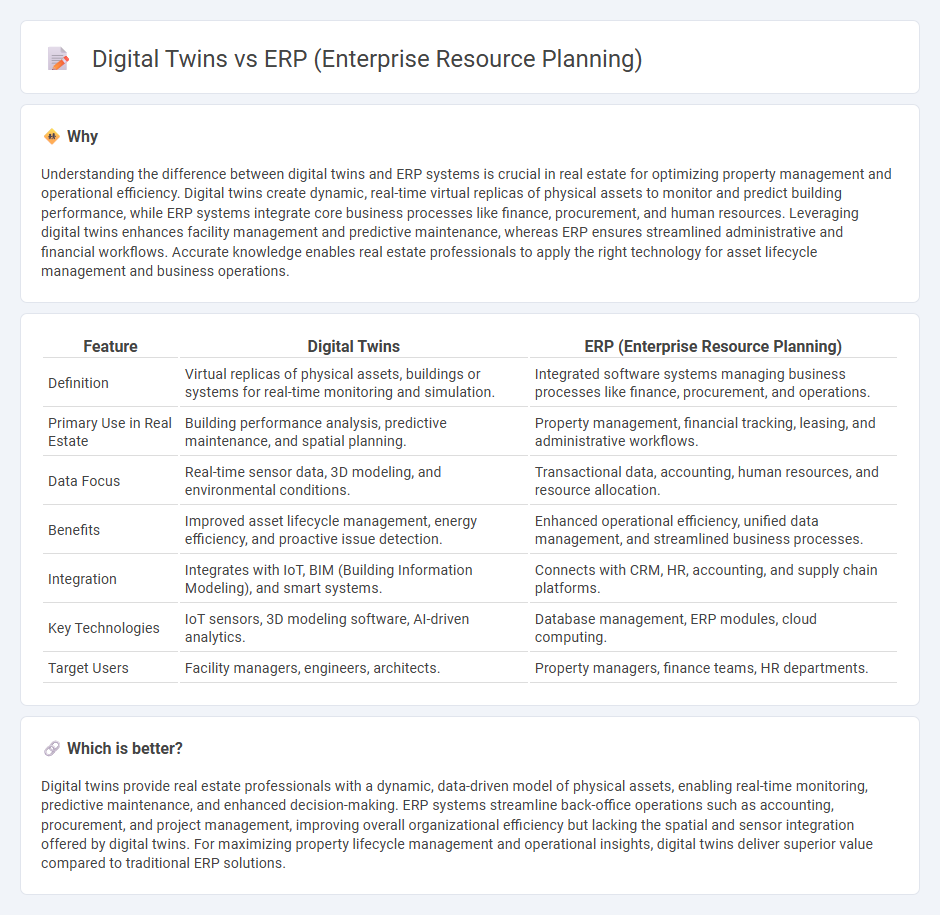
Digital twins create dynamic, real-time virtual models of physical properties, enabling precise monitoring and predictive maintenance in real estate management. ERP systems streamline business processes by integrating data across departments such as finance, sales, and operations to enhance efficiency and decision-making. Explore how combining digital twins with ERP can revolutionize property management and investment strategies.
Why it is important
Understanding the difference between digital twins and ERP systems is crucial in real estate for optimizing property management and operational efficiency. Digital twins create dynamic, real-time virtual replicas of physical assets to monitor and predict building performance, while ERP systems integrate core business processes like finance, procurement, and human resources. Leveraging digital twins enhances facility management and predictive maintenance, whereas ERP ensures streamlined administrative and financial workflows. Accurate knowledge enables real estate professionals to apply the right technology for asset lifecycle management and business operations.
Comparison Table
| Feature | Digital Twins | ERP (Enterprise Resource Planning) |
|---|---|---|
| Definition | Virtual replicas of physical assets, buildings or systems for real-time monitoring and simulation. | Integrated software systems managing business processes like finance, procurement, and operations. |
| Primary Use in Real Estate | Building performance analysis, predictive maintenance, and spatial planning. | Property management, financial tracking, leasing, and administrative workflows. |
| Data Focus | Real-time sensor data, 3D modeling, and environmental conditions. | Transactional data, accounting, human resources, and resource allocation. |
| Benefits | Improved asset lifecycle management, energy efficiency, and proactive issue detection. | Enhanced operational efficiency, unified data management, and streamlined business processes. |
| Integration | Integrates with IoT, BIM (Building Information Modeling), and smart systems. | Connects with CRM, HR, accounting, and supply chain platforms. |
| Key Technologies | IoT sensors, 3D modeling software, AI-driven analytics. | Database management, ERP modules, cloud computing. |
| Target Users | Facility managers, engineers, architects. | Property managers, finance teams, HR departments. |
Which is better?
Digital twins provide real estate professionals with a dynamic, data-driven model of physical assets, enabling real-time monitoring, predictive maintenance, and enhanced decision-making. ERP systems streamline back-office operations such as accounting, procurement, and project management, improving overall organizational efficiency but lacking the spatial and sensor integration offered by digital twins. For maximizing property lifecycle management and operational insights, digital twins deliver superior value compared to traditional ERP solutions.
Connection
Digital twins in real estate create virtual replicas of properties, enabling real-time monitoring and predictive maintenance, while ERP systems integrate these data streams to streamline operations, finance, and asset management. The synergy between digital twins and ERP enhances decision-making by providing accurate, up-to-date information on building performance, occupancy, and resource utilization. This integration reduces operational costs, improves sustainability, and maximizes property value through data-driven insights.
Key Terms
Data Integration
ERP systems centralize organizational data from finance, supply chain, and human resources into unified databases, facilitating streamlined data integration across departments. Digital twins generate real-time, dynamic data by simulating physical assets and processes, enabling predictive analysis and operational optimization based on live sensor inputs. Discover how integrating ERP with digital twin technology can enhance decision-making and operational efficiency.
Asset Lifecycle Management
ERP systems streamline Asset Lifecycle Management by integrating core business processes such as procurement, maintenance, and financial tracking into a unified platform, enhancing operational efficiency. Digital twins offer real-time simulation and predictive analytics of physical assets, providing deeper insights into performance, maintenance needs, and lifecycle optimization. Explore how combining ERP and digital twins transforms Asset Lifecycle Management through enhanced data-driven decision-making and operational agility.
Real-time Monitoring
ERP systems centralize business data management, enabling efficient resource planning across departments. Digital twins provide real-time monitoring by creating dynamic virtual replicas of physical assets, facilitating predictive maintenance and operational optimization. Discover how integrating digital twins with ERP enhances real-time insights for smarter decision-making.
Source and External Links
Enterprise Resource Planning - This page provides a comprehensive overview of ERP, including its definition, functions, and benefits in managing business processes.
What is Enterprise Resource Planning (ERP)? - This article explains ERP as a business management software system designed to streamline an organization's functions with automation and integration.
What is ERP? A Comprehensive Guide - This guide details how ERP systems automate business processes, centralize data, and provide insights to improve operational efficiency.
 dowidth.com
dowidth.com